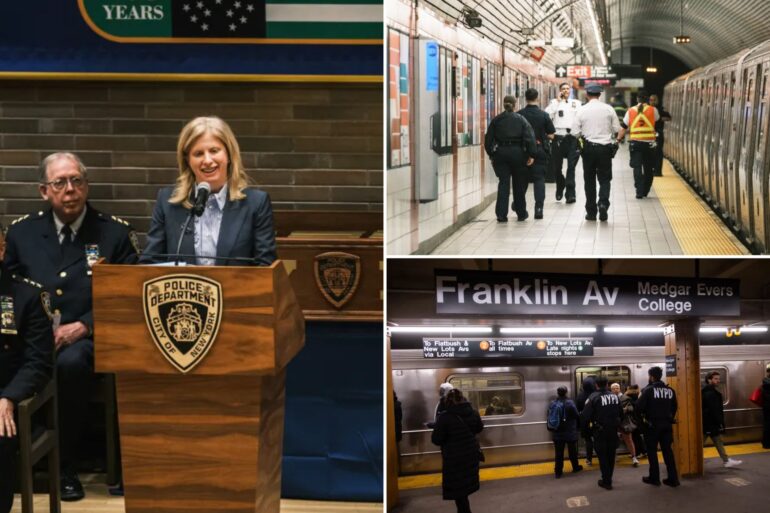🔴 Website 👉 https://u-s-news.com/
Telegram 👉 https://t.me/usnewscom_channel
The NYPD released its crime statistics for the first quarter of 2025 last week, and the results were pretty spectacular.
Six of the seven major crime categories were down, with significant declines in both murders (by 34%) and shootings (by 23%) through the first three months of the year.
Major crimes in the subway — which, for the first time in seven years, saw zero first-quarter murders — dropped by almost 20%.
After four long years of stubbornly high crime, things are finally trending in the right direction.
But understanding the reasons behind the good news makes the platforms of some of those vying to become the city’s next mayor all the more worrisome.
The NYPD’s hard-won success could be frighteningly fragile.
At a press conference last week, NYPD Commissioner Jessica Tisch and Mayor Adams credited much of the progress to three new enforcement initiatives — programs that have been opposed by some of those running for mayor.
First, Tisch’s precision policing approach deployed extra officers and detectives to micro-geographic enclaves with the heaviest concentrations of violent crime.
These areas, known as violence reduction zones, saw stepped-up enforcement — and all are located in precincts with mostly black and Latino residents.
Second was a welcome jump in the share of serious offenses resulting in either an arrest or the identification of an individual suspect — what those in the field call the “clearance rate.”
Third was a fresh emphasis on maintaining order within the subway system, with a surge of cops patrolling trains in the overnight hours.
That approach was sold as a means of nabbing criminals with open warrants, and the numbers back it up: 31% of those arrested in the subways were convicted felons.
Collectively, those arrested for subway misbehavior had an average of 21 prior arrests, highlighting an ongoing recidivism problem that Tisch and Adams have rightly attributed to recent bail, discovery and juvenile justice “reforms.”
Throughout the city, 39% of those arrested in the first quarter “were arrested at least twice in the same three-month period,” Tisch said. One in five “were arrested three or more times” during those months.
But while Tisch’s crackdown on recidivists may be paying off, many mayoral candidates seem unlikely to support it should they win.
Front-runner Andrew Cuomo was the governor who signed into law all three of the recent criminal-justice laws blamed for the recidivism explosion.
Fellow Democrats Zellnor Myrie and Zohran Mamdani voted for those laws as state legislators.
Cuomo also oversaw the closing of 24 state prisons and juvenile detention centers — and pushed then-mayor Bill DeBlasio to speed up the closing of the Rikers Island jail complex.
The recent uptick in police enforcement has zoomed the city’s jail population to well over 7,100 inmates.
That’s 700 more than were behind bars last year — and more than double the maximum capacity of the borough-based jail system that’s supposed to replace Rikers in two years.
If Tisch’s enforcement measures continue, the jail population will be more than 7,400 by next year, according to the Data Collective for Justice.
The math does itself. But soft-on-crime candidates like Brad Lander, Mamdani and Myrie haven’t uttered a word of reservation about the coming drastic cuts to the city’s jail capacity.
Adams, by contrast, has repeatedly called out the need to increase the city’s future jail capacity.
And what about the fact that the NYPD’s precision policing model concentrates enforcement in minority neighborhoods?
The sane among us understand that this policy disproportionately benefits the law-abiding residents of those communities — but many of those looking to move into Gracie Mansion have a long record of opposing police initiatives that produce racial disparities in enforcement.
Same goes for the “broken windows” approach currently in play within the subway system: Mamdani, for example, would rather make transit free than enforce laws against fare evasion.
Cuomo claims to favor precision policing, but the package of police reforms he hurriedly signed into law after the death of George Floyd in 2020 suggests that his commitment may not be as durable as city residents need it to be.
New Yorkers should celebrate the current crime trends. Things are most certainly moving in the right direction.
But it would be a grievous mistake to take this good news for granted.
Progress doesn’t just happen. We have a pretty good idea about what’s working.
What we don’t have is any guarantee that the next mayor of New York will maintain this successful course.
Rafael A. Mangual is a Manhattan Institute fellow and author of “Criminal (In)Justice: What The Push For Decarceration And Depolicing Gets Wrong And Who It Hurts Most.”

